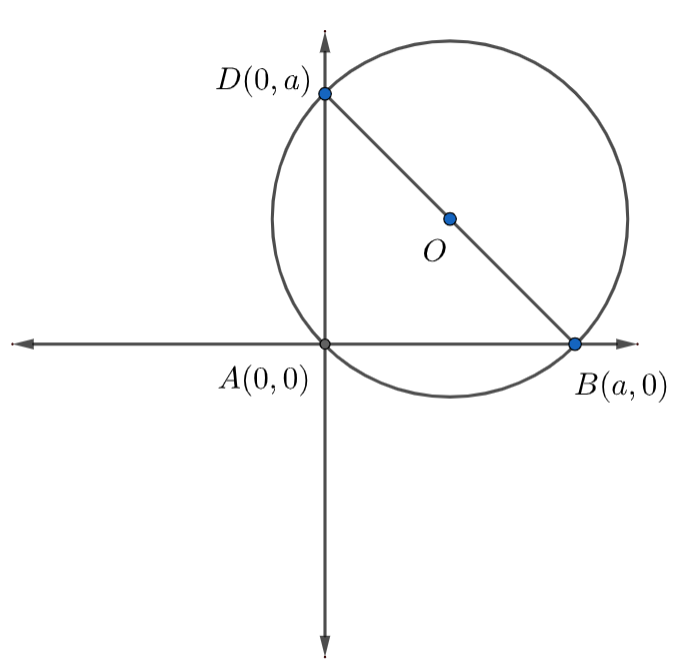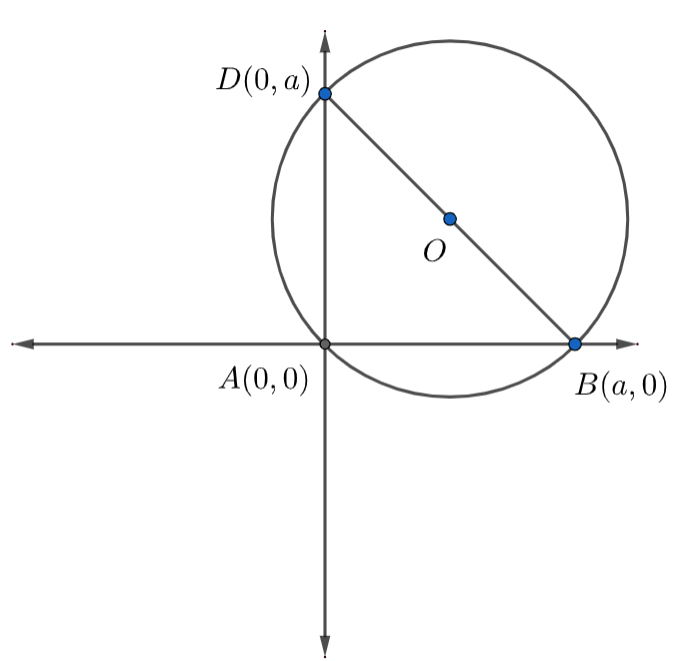
ABD is a triangle whose side is a, taking AB and AD as axes, prove that the equation of the circle circumscribing the triangle is \[{{x}^{2}}+{{y}^{2}}-a\left( x+y \right)=0\].
Answer
463.5k+ views
Hint: The sides AB and AD are lying on the x-axis and y-axis respectively. The length of the sides AB and AD is equal to \[a\] units and point A is lying at the origin. The coordinates of point B and point D are \[\left( a,0 \right)\] and \[\left( 0,a \right)\] . Now, from the figure, we can see that the points B and D are the endpoints of the diameter of the given circle. We know the formula that the equation of the circle having \[\left( {{x}_{1}},{{y}_{1}} \right)\] and \[\left( {{x}_{2}},{{y}_{2}} \right)\] as the endpoints of the diameter is \[\left( x-{{x}_{1}} \right)\left( x-{{x}_{2}} \right)+\left( y-{{y}_{1}} \right)\left( y-{{y}_{2}} \right)=0\] . Now, use this formula here and get the equation of the required circle.
Complete step-by-step solution
According to the question, it is given that ABD is a triangle whose sides are equal to a, taking AB and AD as axes.
It means that the sides AB and AD are lying on the x-axis and y-axis respectively.
The length of the side of the triangle = a unit………………………………………(1)
Since the side, AB is lying on the x-axis and the length of the side of the triangle is \[a\] units. So, point B will be at a distance \[a\] units from A which is at the origin. Similarly, the side AD is lying on the y-axis and the length of the side of the triangle is \[a\]. So, point D will be at a distance \[a\] units from A which is at the origin. Therefore,
The coordinate of point B = \[\left( a,0 \right)\] …………………………………….(2)
The coordinate of point D = \[\left( 0,a \right)\] ………………………………………(3)

We know the formula that the equation of the circle having \[\left( {{x}_{1}},{{y}_{1}} \right)\] and \[\left( {{x}_{2}},{{y}_{2}} \right)\] as the endpoints of the diameter is \[\left( x-{{x}_{1}} \right)\left( x-{{x}_{2}} \right)+\left( y-{{y}_{1}} \right)\left( y-{{y}_{2}} \right)=0\] ………………………………………..(4)
Now, from the figure, we can see that the line BD is the diameter of the circle circumscribing the triangle. It means that the points B and D are the endpoints of the diameter of the given circle ………………………………………………(5)
From equation (2) and equation (3), we have the coordinate of the point B and point D respectively ………………………………………………(6)
Now, from equation (4), equation (5), and equation (6), we have
The equation of the circle,
\[\begin{align}
& \Rightarrow \left( x-a \right)\left( x-0 \right)+\left( y-0 \right)\left( y-a \right)=0 \\
& \Rightarrow {{x}^{2}}-ax+{{y}^{2}}-ay=0 \\
\end{align}\]
\[\Rightarrow {{x}^{2}}+{{y}^{2}}-ax-ay=0\] ………………………………………(7)
Therefore, the equation of the circle circumscribing the triangle is \[{{x}^{2}}+{{y}^{2}}-ax-ay=0\] .
Hence, Proved.
Note: We can also calculate the coordinate of the center of the circle by using the midpoint formula.

In the figure, we can see that the points BD is the diameter whose center is at point O.
We know the property that the center is the midpoint of the endpoints of the diameter.
Using this property, we can say that the point O is the mid-point of the points B and D …………………………………………..(1)
The coordinate of point B = \[\left( a,0 \right)\] …………………………………….(2)
The coordinate of point D = \[\left( 0,a \right)\] ………………………………………(3)
We know the formula for the coordinate of the midpoint joining the points having the coordinates
\[\left( {{x}_{1}},{{y}_{1}} \right)\] and \[\left( {{x}_{2}},{{y}_{2}} \right)\] = \[\left( \dfrac{{{x}_{1}}+{{x}_{2}}}{2},\dfrac{{{y}_{1}}+{{y}_{2}}}{2} \right)\] ……………………………………………..(4)
From equation (1), equation (2), equation (3), and equation (4), we have
The coordinate of point O = \[\left( \dfrac{a+0}{2},\dfrac{0+a}{2} \right)=\left( \dfrac{a}{2},\dfrac{a}{2} \right)\] ………………………………………..(9)
Also, we have O as the center of the given circle.
Therefore, the coordinate of the center of the circle = \[\left( \dfrac{a}{2},\dfrac{a}{2} \right)\] .
Complete step-by-step solution
According to the question, it is given that ABD is a triangle whose sides are equal to a, taking AB and AD as axes.
It means that the sides AB and AD are lying on the x-axis and y-axis respectively.
The length of the side of the triangle = a unit………………………………………(1)
Since the side, AB is lying on the x-axis and the length of the side of the triangle is \[a\] units. So, point B will be at a distance \[a\] units from A which is at the origin. Similarly, the side AD is lying on the y-axis and the length of the side of the triangle is \[a\]. So, point D will be at a distance \[a\] units from A which is at the origin. Therefore,
The coordinate of point B = \[\left( a,0 \right)\] …………………………………….(2)
The coordinate of point D = \[\left( 0,a \right)\] ………………………………………(3)

We know the formula that the equation of the circle having \[\left( {{x}_{1}},{{y}_{1}} \right)\] and \[\left( {{x}_{2}},{{y}_{2}} \right)\] as the endpoints of the diameter is \[\left( x-{{x}_{1}} \right)\left( x-{{x}_{2}} \right)+\left( y-{{y}_{1}} \right)\left( y-{{y}_{2}} \right)=0\] ………………………………………..(4)
Now, from the figure, we can see that the line BD is the diameter of the circle circumscribing the triangle. It means that the points B and D are the endpoints of the diameter of the given circle ………………………………………………(5)
From equation (2) and equation (3), we have the coordinate of the point B and point D respectively ………………………………………………(6)
Now, from equation (4), equation (5), and equation (6), we have
The equation of the circle,
\[\begin{align}
& \Rightarrow \left( x-a \right)\left( x-0 \right)+\left( y-0 \right)\left( y-a \right)=0 \\
& \Rightarrow {{x}^{2}}-ax+{{y}^{2}}-ay=0 \\
\end{align}\]
\[\Rightarrow {{x}^{2}}+{{y}^{2}}-ax-ay=0\] ………………………………………(7)
Therefore, the equation of the circle circumscribing the triangle is \[{{x}^{2}}+{{y}^{2}}-ax-ay=0\] .
Hence, Proved.
Note: We can also calculate the coordinate of the center of the circle by using the midpoint formula.

In the figure, we can see that the points BD is the diameter whose center is at point O.
We know the property that the center is the midpoint of the endpoints of the diameter.
Using this property, we can say that the point O is the mid-point of the points B and D …………………………………………..(1)
The coordinate of point B = \[\left( a,0 \right)\] …………………………………….(2)
The coordinate of point D = \[\left( 0,a \right)\] ………………………………………(3)
We know the formula for the coordinate of the midpoint joining the points having the coordinates
\[\left( {{x}_{1}},{{y}_{1}} \right)\] and \[\left( {{x}_{2}},{{y}_{2}} \right)\] = \[\left( \dfrac{{{x}_{1}}+{{x}_{2}}}{2},\dfrac{{{y}_{1}}+{{y}_{2}}}{2} \right)\] ……………………………………………..(4)
From equation (1), equation (2), equation (3), and equation (4), we have
The coordinate of point O = \[\left( \dfrac{a+0}{2},\dfrac{0+a}{2} \right)=\left( \dfrac{a}{2},\dfrac{a}{2} \right)\] ………………………………………..(9)
Also, we have O as the center of the given circle.
Therefore, the coordinate of the center of the circle = \[\left( \dfrac{a}{2},\dfrac{a}{2} \right)\] .
Recently Updated Pages
What percentage of the area in India is covered by class 10 social science CBSE

The area of a 6m wide road outside a garden in all class 10 maths CBSE

What is the electric flux through a cube of side 1 class 10 physics CBSE

If one root of x2 x k 0 maybe the square of the other class 10 maths CBSE

The radius and height of a cylinder are in the ratio class 10 maths CBSE

An almirah is sold for 5400 Rs after allowing a discount class 10 maths CBSE

Trending doubts
The Equation xxx + 2 is Satisfied when x is Equal to Class 10 Maths

Why is there a time difference of about 5 hours between class 10 social science CBSE

Who was Subhash Chandra Bose Why was he called Net class 10 english CBSE

Change the following sentences into negative and interrogative class 10 english CBSE

Write a letter to the principal requesting him to grant class 10 english CBSE

Explain the Treaty of Vienna of 1815 class 10 social science CBSE




